An Introduction to Troemner ASTM Balance Calibration Weights
Troemner offers the most comprehensive selection of calibration weights, scale weights, test weights, and precision mass standards. Our weight selection includes every imaginable size, class, and type from 5,000 lb. weights to the extremely precise 0.05 mg weights. Troemner’s portfolio of calibration weights includes our highly polished stainless-steel weights that exceed the exacting requirements of ANSI/ASTM E617.
In this article, we will focus on ASTM Class 1, Class 2, Class 3, and Class 4 calibration weights. These calibration weights are typically used for routine testing and calibration of analytical balances and other laboratory balances as well as calibration of other weights.
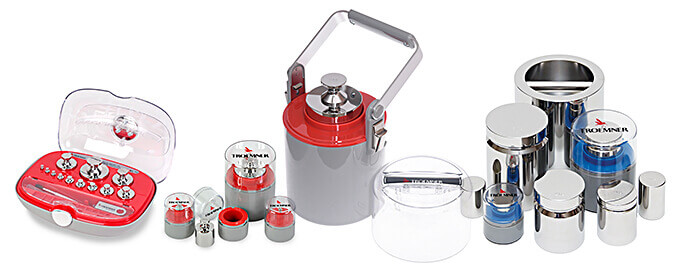
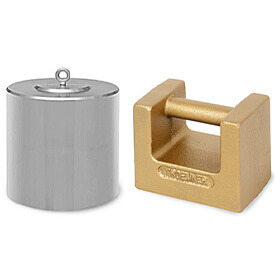
If you are looking for ASTM Class 5 to 7, explorer our Scale Weights and Test Weights. Typically used for routine testing and calibration of weighing scales, floor scales, and other industrial scales, Scale weights and test weights are ideal for testing commercial weighing devices and may be used to test most accuracy Class III scales and Class IIIL or IIII scales. Scale weights and weight sets are available in ASTM Class 5, Class 6 (replaces NIST Class F), and Class 7.
Calibration Weights Overview
If there is an analytical balance in a laboratory, there will be calibration weights. Calibration weights are essential for routine checking and calibration of weighing devices including micro balances, analytical balances, precision balances, top loading balances, and other masses in a laboratory. Through a series of measurements calibration weights are used to ensure laboratory balances are providing dependable and accurate readings and are a crucial element in a laboratory’s mass measurement assurance program. Industries such as biotechnology, pharmaceutical, food processing, agriculture, cosmetics, general research and development, and manufacturing rely on balances or scales with calibration weights in their daily operations.
Each calibration weight has specific characteristics defined by the internationally recognized weight standard ANSI/ASTM E617, Standard Specification for Laboratory Weights and Precision Mass Standards. The class of the weight is a key characteristic with a stated maximum permissible error, also known as tolerance or accuracy of the weight.
The general recommendation is the accuracy of the calibration weight should be at least equal to 1/3 the readability of the balance or scale. Therefore, the readability of the weighing device determines the precision of the calibration weight. A review of the weight standard then identifies the weight class that is necessary for the calibration weight for a particular balance or scale.
Accreditation
Accreditation is the independent evaluation of conformity against recognized standards to conduct specific activities to ensure impartiality and competence. Through the application of national and international standards, governments, procurers, and consumers can have confidence in the calibration and test results, inspection reports and certifications provided.
For calibrated weights, accreditation ensures all mass laboratories are playing by the same rules to perform calibrations. All Calibration Laboratories must meet the requirements of the same standard with an external third party making sure the rules are followed.
International Standards
ISO - International Organization for Standardization
ISO is the world’s largest developer of voluntary International Standards. International Standards give state of the art specifications for products, services, and good practices. ISO is an independent, non-government organization that develops the standards through global consensus practices.
ISO/IEC 17025 – General Requirements for the competence of testing and calibration laboratories
ISO/IEC 17025 specifies the general requirements for the quality and competence to conduct tests and/or calibrations and delivering consistent, reliable results. It is applicable to all organizations performing tests and/or calibrations.
NVLAP – National Voluntary Laboratory Accreditation Program
NVLAP (National Voluntary Laboratory Accreditation Program (NVLAP) | NIST) falls under the guidance of NIST (National Institute of Standards and Technology (nist.gov)), part of the U.S. Department of Commerce. NVLAP accreditation audits ensure a calibration laboratory’s compliance to ISO/IEC 17025 and NIST Handbook 150. This independent, third part assessment ensures the science of measurement and laboratory processes are sound and consistently followed.
Troemner ISO 17025 Certificate
Troemner NVLAP Scope of Accreditation to ISO/IEC 17025:2017, NVLAP Lab Code 105013-0
International Calibration Weight Standard
ANSI/ASTM E617, Standard Specification for Laboratory Weights and Precision Mass Standards
Troemner calibration weights are available in ANSI/ASTM E617 Class 1, Class 2, Class 3, and Class 4. These calibration weights meet or exceed specifications as defined in the standard.
In the ANSI/ASTM E617 standard, the weight specifications are designed so the requirements for surface finish, markings, construction, material density and magnetic properties become more restrictive as weight tolerances decrease to enable the weight to maintain its tolerance over time. The tolerances for the various classes are established in a manner that enables the weights of higher classes to calibrate weights of the next lower class.
Explore ASTM Calibration Weights
Calibration Weight Styles and Construction
Shop ASTM Class 1-4 Cylindrical and Knob Style Calibration WeightsASTM Gram and Kilogram Style Calibration Weights
Troemner ASTM knob style calibration weights 1 g and larger consist of a body and a lifting knob. The lifting knob is specifically designed for use with forceps or other lifting device. Weight bottoms are slightly recessed to expose the smallest possible area to wear. Each calibration weight is marked with its nominal value for ANSI/ASTM Class 1, 2, 3, 4.
ANSI/ASTM Weight Style
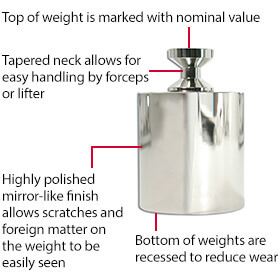
Troemner ASTM knob style calibration weights are available in either one-piece or two-piece construction as defined by the standard and weight class.
Two-piece construction means the calibration weight is made of multiple pieces of stainless steel. Troemner ANSI/ASTM Classes 1, 2, 3, 4 weights 1 g and larger are produced from two pieces of material. The body of the weight is the primary piece, and the knob of the weight is the secondary piece. The knob has a thread that screws into the body and is tightened. There is a cavity below the knob thread in the body which contains adjusting material, typically the same material from which the weight is made.
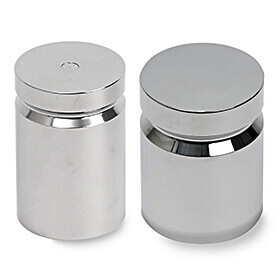
All surfaces are polished to a perfect, mirror-like finish and conform to specifications in ANSI/ASTM E617. The mirror-finish is an ultra-smooth surface with no visible imperfections. This surface is easier to maintain and clean over time and with proper handling will resist the buildup of material; thus, maintaining the mass value of the weight.
Cylindrical Style ASTM Electronic Balance Gram and Kilogram Calibration Weights
Troemner Cylindrical Style ASTM Electronic Balance Gram and Kilogram calibration weights are marked with their nominal value for ANSI/ASTM Class 1, 2, 3, 4.
Classes 1, 2, and 3 all have surfaces polished to a perfect, mirror-like finish while Class 4 weights have a satin-like appearance and finish. All surface finishes meet or exceed ANSI/ASTM E617 specifications.
Cylindrical style electronic balance calibration weights are manufactured from high-quality stainless steel and are two-piece construction with a cavity that allows for adjustment during future calibrations. Within the cavity there is adjusting material, typically the same material from which the weight is made. This cavity is sealed during the production process to ensure the stability of the weight. Electronic balance calibration weights are cylindrical in shape and flat on top to stack easy on center.
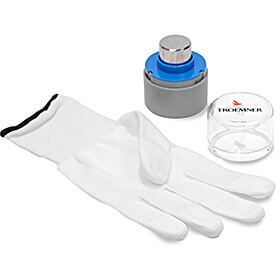
Straight Cylinder Style ASTM Electronic Balance Calibration Weights
Weights from 10 g through 600 g are machined as straight cylinders with the adjusting cavity opening in the bottom of the weight.
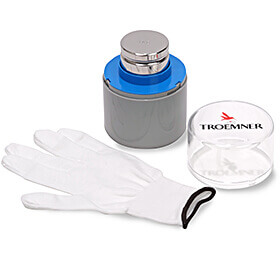
Grooved Cylindrical Style ASTM Electronic Balance Calibration Weights
Cylindrical weights from 1 kg to 5 kg are machined as cylinders and have a groove around the diameter approximately 25% from the top of the weight to allow for easier handling. The adjusting cavity opening is in the bottom of the weight.
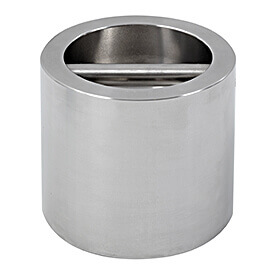
Grip Handle Style ASTM Electronic Balance Calibration Weights
Grip handle calibration weights from 4 kg through 30 kg have a recess in the top center of the weight with a lifting handle spanning the recess slightly below the top surface of the weight. The recess allows the user to pick up the weight using the handle and provides clearance for the user’s hand. Grip handle weights 4 kg to 10 kg are 5 inches in diameter. Grip handle weights above 10 kg through 30 kg are 6 inches in diameter. The adjusting cavity for grip handle weights is within the lifting handle.
Shop ASTM Class 1-4 Grip Handle Calibration Weights
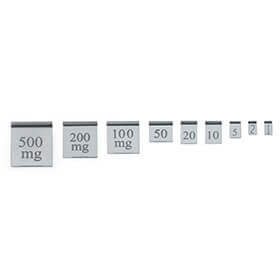
Milligram Weights
Troemner Precision Milligram Flat Weights 500 mg and below are sheet metal and one-piece construction with one side turned up to make them easy to handle with forceps. Milligram weights are marked with their nominal value for ANSI/ASTM Classes 1, 2, 3, 4.
Shop ASTM Class 1-4 Flat Calibration Weights
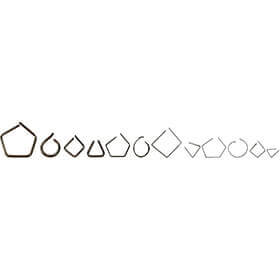
Milligram Wire Weights
Troemner Precision Milligram Wire Weights 500 mg and below are also available in wire construction with the shape denoting the nominal value according to the table below. These weights are constructed with one end turned up to allow for easy handling with forceps.
Shop ASTM Class 1-4 Wire Calibration Weights
Shape | Denomination |
Pentagon | 500 mg, 50 mg, 5 mg |
Circle | 300 mg, 30 mg, 3 mg |
Square | 200 mg, 20 mg, 2 mg |
Triangle | 100 mg, 10 mg, 1 mg |
Calibration Weight Materials
Troemner Alloy 8
In 2003, Troemner began manufacturing stainless steel weights using a new, unique material specifically designed to meet the many demands required of calibration weights. Calibration weights require consistent density, low magnetic properties, extremely smooth surface finish and high hardness to prevent wear. Intensive research and testing of various stainless steels identified the optimal material to manufacture calibration weights and resulted in Troemner Alloy 8 Stainless Steel. This is the finest commercially available stainless steel for high precision calibration weights and mass standards. In fact, Alloy 8 meets and exceeds all stainless-steel material specifications NBS (now NIST) specified when purchasing the original U.S. state laboratory mass standards over 60 years ago.
Troemner calibration weights made from Alloy 8 Stainless Steel provide you with the following benefits:
Low Magnetic Properties – The most important attribute of Troemner Alloy 8 is its extremely low magnetic properties. The magnetic susceptibility specification for Troemner Alloy 8 exceeds the published requirements in ANSI/ASTM E617. A magnetized weight may affect a balance’s weighing cells introducing errors into the measurement process. Troemner Alloy 8 prevents these problems.
Consistent Density – Troemner Alloy 8 is purchased as bar stock and then fabricated into calibration weights through Troemner’s in-house Machine Shop. Purchasing bars of material assures consistency in the material density across the weights formed from that bar. Troemner reports a density of 8.03 g/cm3 for Alloy 8. This value was established after testing many samples using our NVLAP accredited density determination calibration process (NVLAP Lab Code 105013-0). This material consistency is important when weights are subsequently recalibrated after the initial sale due to the reported density is used to make buoyancy corrections during calibrations. Variations in material density can influence the calibrated value assigned to weights.
Surface Finish and Hardness – Troemner Alloy 8 is significantly harder than other stainless steels. The benefit to the user of a harder material is it is less susceptible to wear and scratches. A weight made of harder stainless steel is less likely to lose enough mass to move it out of its adjusted tolerance value.
Troemner calibration weights manufactured with Alloy 8 are:
- ASTM E617, Classes 1, 2, 3 and 4
- Nominal values 1 g thru 1 kg
Overall, a calibration weight manufactured using Troemner Alloy 8 will have extremely low magnetic properties, consistent density, and the mirror-like highly polished finish you have come to expect from Troemner to meet today’s rigorous laboratory requirements.
Advantages of Using Weights Made from Troemner Alloy 8 Stainless Steel
316 Stainless Steel
For larger nominal values and wire style milligram weights Troemner uses 316 Stainless Steel. 316 Stainless Steel is an austenitic, corrosion-resistant steel that has high strength and hardness properties. This blend of stainless steel is highly resistant to pitting and corrosion and when polished will have a perfect mirror-like finish. This grade of stainless steel also has excellent, consistent density at 7.95 g/cm3 which is particularly important in the production of calibration weights. The density and resistance to magnetism of this material meet the exacting requirements of the ASTM E617 weight standard.
Troemner calibration weights manufactured with 316 Stainless Steel are:
- ASTM E617, Classes 1, 2, 3 and 4
- Nominal values 2 kg – 50 kg
Troemner electronic balance calibration weights manufactured with 316 Stainless Steel are:
- ASTM E617, Classes 1, 2, 3 and 4
- Nominal Values 10 g – 1500 g
304 Stainless Steel
304 Stainless Steel is used in the production of Troemner’s larger electronic balance calibration weights, flat sheet style milligram weights, and small pound and ounce nominal values. This grade of stainless steel is a general-purpose material and widely used in many industries. The resistance to corrosion and consistent density at 7.95 g/cm3 of 304 Stainless Steel meets the requirements in ASTM E617 for the manufacture of weights.
Troemner electronic balance calibration weights manufactured with 304 Stainless Steel are:
- ASTM E617, Classes 1, 2, 3 and 4
- Nominal Values 2 kg – 30 kg
3003 – H14 Aluminum
3003 – H14 Aluminum is an alloy that is used at Troemner for our smallest milligram weights. This material can be found in a variety of applications throughout many industries. This material is corrosion resistant and has a consistent density of 2.7 g/cm3 meeting the requirements in the ASTM E617 standard for milligram weights.
Calibration Weight Styles, Classes, and Typical Markets
Weight Style | ASTM | Suggested Markets |
ASTM Calibration Weights | ASTM E617 | Pharmaceutical, Biotech, Nanotechnology, Life Science Forensic and Nuclear Industries |
Cal Paks | ASTM Class 1 | Three weights in a set for maintenance of analytical balances and other laboratory balances |
Electronic Balance | ASTM E617 | Ideal for non-chemical environments to verify balances and scales |
Nominal Value Ranges
Troemner offers an extensive selection of individual calibration weights and weight sets that meet the requirements of ANSI/ASTM E617. Whether you need just one weight or a full set, Troemner has precisely what you need for your Laboratory.
ANSI/ASTM Calibration Weights
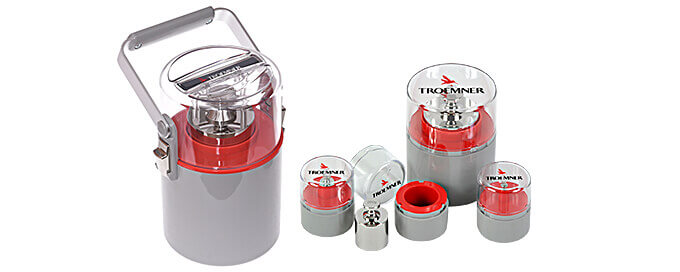
ASTM E617 Class | Individual Weights | Weight Sets** |
1 | 50 kg to 0.05 mg
| Largest set range 50 kg to 1 mg
|
2, 3, 4 | 50 kg to 0.05 mg
| Largest set range 50 kg to 1 mg
|
** Troemner weight sets are supplied in a 5-2-2-1 series. 5-2-2-1 means that weights beginning with a “2” are doubled in each decade and weights beginning with a “5” and “1” are single in each decade.
Example: a set with 5-2-2-1 series from 50 g to 1 g includes one 50 g, two 20 g, one 10 g, one 5 g, two 2 g, and one 1 g.
Electronic Balance Calibration Weights
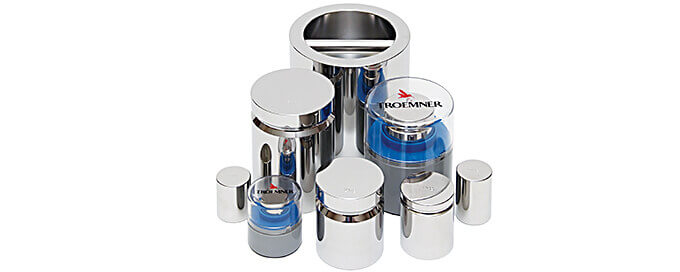
ASTM E617 Class | Individual Weights | Weight Set |
1, 2, 3, 4 | 30 kg to 10 g
| One each of the following:
|
FAQ's
What should I keep in mind when selecting calibration weights?
There are several classes, shapes, styles, construction, materials, and sizes available to meet your needs.
Selecting the proper calibration weight for your application can be confusing given the number of weight classes, designs, and materials available. The following information can help in your weight selection process.
The following issues need to be considered when selecting weights:
1. Application Accuracy
The correct weight for an application should be more accurate than the precision of the weighing device and must be more accurate than the required precision of your measurement result. It is recommended that a weight have an accuracy that is one-third of the measurement device readability and/or your measurement accuracy requirement.
2. Environment
Temperature and humidity can impact the stability of weights. We recommend stainless steel weights for applications in environments that have excess moisture. Stainless steel weights are much less prone to physical change as compared to cast iron.
Cleanliness of the environment can impact how stable your weights will be over time. Environments with excessive airborne matter, such as dust, can impact the stability of weights. The smoother the surface of a weight, the easier it is to see foreign matter so it can be removed.
3. Reported Uncertainty on Calibration
The uncertainty reported on a calibration is just as important as the measured value itself. The uncertainty provides the statistical confidence that a laboratory has on its calibration process. The larger the uncertainty, the less confidence in the measured value. It is also important to realize that a measured value added to its associated uncertainty must be less than the tolerance for the weight to be considered within class tolerance.
Learn more about weight uncertainties at https://www.troemner.com/calibration-uncertainty and weight tolerances at https://www.troemner.com/reference-center/weights-reference-center/calibration-weight-tolerance.
4. Certification
Troemner offers a variety of calibration certificates to meet your specific needs for certified weights for calibration. Certificates are described in detail at Certificate Options.
5. Special Design or Construction
Troemner manufactures a variety of special application weights, such as weights with hooks or weights that can be stacked on a hanger to build up the total weight. Keep in mind that if you do not see what you need, please contact a Troemner Sales Representative to discuss your special weight requirements.
6. How Often Should I Have My Weights Calibrated? Why? Are There Any Regulations and/or Standards Pertaining to Calibration Intervals?
It is recommended that if you use your weights infrequently to moderately, you should have them recalibrated once a year. However, if your weights are used very frequently or several times a day, then you should have them calibrated once every six months. Although there are no standards or regulations that specifically address recalibration intervals, this is the industry norm to ensure that these standards are still within their specified tolerances. It is not unusual to see significant “as found” failure rates on those weights that are not recalibrated on an annual basis.
Have other specifics questions, explore additional FAQs in the Weights Reference Center or for more general questions, explore the complete list of FAQs






